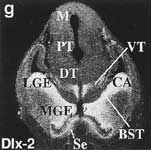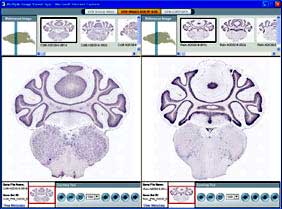 | Allen Institute for Brain Science |
 | Allen Institute for Brain Science |
|
By Ellen Kuwana Neuroscience for Kids Staff Writer September 26, 2003
|
| The altas will be made by mapping gene expression patterns using a technique developed in 1969 called in situ hybridization. ISH is a method for detecting specific nucleic acid sequences. Mouse brains will be preserved and cut into sections that are thinner than a human hair. These sections are placed onto microscope slides, and processed with a genetic "probe." A probe is a specially labelled piece of nucleic acid that results in visualization of the desired gene expression pattern in the tissue section. Thus, bit by bit, the pattern (expression pattern) of a gene can be determined. Hundreds of sections will then be reassembled using computers, creating a 3-D representation of a specific gene pattern within the brain. This will be repeated for many genes, some of which have known functions, others with functions that are mysteries. |  Gene expression pattern in mouse embryo. Photo by Ellen Kuwana. |
This new project, which is expected to take five years, will generate an
unprecedented amount of information, most of which will be made available
on the Internet. To put this amount of information in perspective, the Web
now houses about eight petabytes of information; this brain mapping
project is expected to generate several petabytes of data. (One petabyte
is equal to one thousand trillion bytes.)  The Allen Institute predicts that they will publish initial results by early 2004.
"The fact that from only 30,000 genes, you can build the brain--something with a trillion nerve cells in it--that's a fascinating thing. When you think about the medical treatment and disease implications of having a better understanding of the genes in the brain, it's just such a fertile area. To have a chance to accelerate that--it's a fantastic opportunity." - Paul Allen (Seattle Times)
Did You Know? Special thanks to Jason E. Long, PhD, for his contributions to this article. |
References and further information:
|
| GO TO: | Neuroscience In The News | Explore the Nervous System | Table of Contents |
![[email]](./gif/menue.gif) Send E-mail |
 Fill out survey |
 Get Newsletter |
 Search Pages |
 Take Notes |